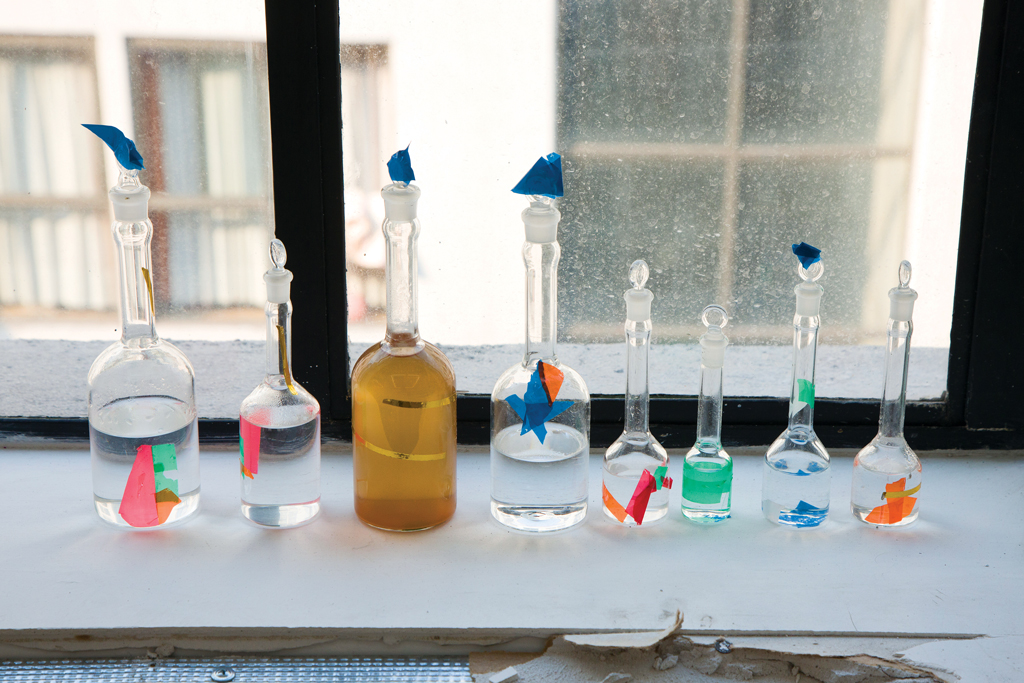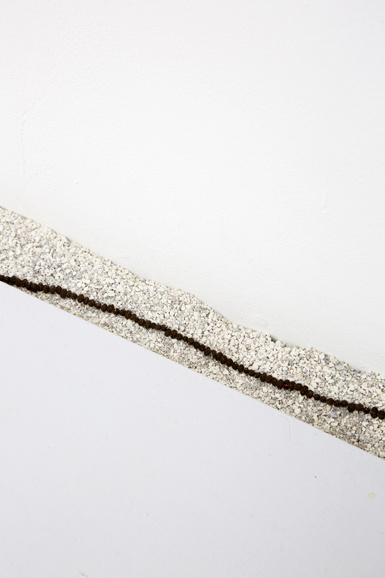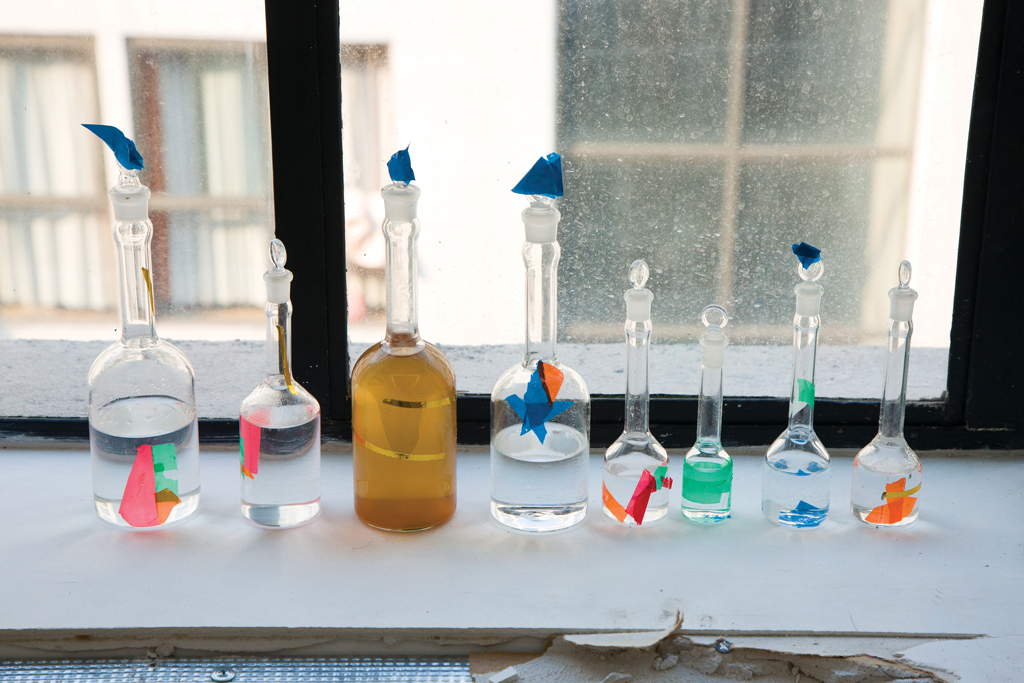[ad_1]

Oa4s, Denunciatron (detail), 2018, custom laboratory equipment and other mixed media, dimensions variable, installation view. Lodos.
RAMIRO CHAVES/COURTESY THE ARTIST AND LODOS, MEXICO CITY
Each February, the MACO and Material art fairs touch down in Mexico City, and most of the work exhibited around the city tends to share either a “portable art” sensibility or a blockbuster “you can’t afford this” monumentality. Yet there was a theme this year that likely arose from the ruins left by a devastating earthquake last September. Nature’s violence pushed many of the city’s inhabitants into the violet smoke that is faith, religion, and superstition—and it was seen as much in minimalist sculpture as in the thick-layered fervor that native chilangos flaunt for Semana Santa (“Holy Week”). The ghostly fog of mysticism floated over the city and its art scene, with results that were sometimes infused with religion, but mostly related to alternative beliefs. An eye set to spot them found allusions to rebirth, witchcraft, and ritual all over the place.
One example was Tomás Díaz Cedeño’s Vessels at BWSMX, his first solo show at the gallery that emerged last year from the closing down of Yautepec, where he had presented “wetworks” in 2015. That show featured a gang of 6½-foot plaster panel sculptures that menacingly surrounded the visitor; here, Díaz Cedeño’s pieces—still large—hung on the walls. The most striking of them faced viewers directly as they entered the gallery: a fleshy, dark pink, folding silhouette, some of its edges roughly sewn with black string; beside it, intriguingly, hung a crown of thorns. The piece draped angularly, its folds and holes gaping like injuries. The rest of the pieces in the show, while less evocative of crucifixion, took a decidedly esoteric approach to materials: furs, huizache branches, seeds, roots, and snakeskin, all bent and tucked together in earth-toned wrappings. They had one foot in the ordinary world of plaster and concrete, and the other, dangling in the great beyond of hexes and sacraments.

Nancy Lupo, Untitled (detail), 2018, kitty litter (Pets Club), Nylabone Tug, two-cast aluminum Nylabone tugs, rainbow string, papaya seeds, Tea Tree Therapy mint toothpick, orange stick, sticky tack and Cooper Union bronze medal, dimensions variable. Lulu.
COURTESY THE ARTIST AND LULU
A similar situation pertained at the second iteration of the Lulu gallery’s Lulennial, a small-scale take on the biennial format. Based entirely around fruit, it was meant to bring comic relief and levity to the politically charged run of recent biennials, but as artist Tobías Dirty asked me rhetorically, “respite for whom and from what, exactly?” From the political struggles that millions of people can’t afford to take a break from? Alright, then.
Nancy Lupo’s piece stood out among the Lulennial’s predictable paintings and sculptures of fruits. She invests everyday objects with a strangeness and impracticality that gives them a devotional feel. It’s hard to imagine the purpose of a long string of papaya seeds lying in a little canal filled with kitty litter surrounding the tiny Lulu gallery, tied to extra-durable Nylabone doggy chew toys, two of them actually aluminum casts of the original hard plastic ones, and one topped with the complex cherry of a Cooper Union bronze medal perforated to fit. Possibly a contemporary offering of some sort.
Then there was “Spirit butterfly X” at Lodos, a show by Oa4s, the artist duo Temra Pavlović and Michael Ray-Von. Anchored on the symbolism of transformation and rebirth attributed to butterflies, the exhibition was a good metaphor post-earthquake, but the point seemed to be constant transformation, a permanent vibration that erases the boundaries between things, humans, animals, art, ghosts. The space was transformed into a paranormal lab where chemistry equipment stood ready to decant beans and sticks into unknown substances, projections danced on mosquito nets, and a flexible hose connected to an air extractor snaked across the room, sharing oxygen with the outside world through a window. Their drawings, titled “Night Drawings” and “Spirit Drawings,” were sandwiched in glass or hovered above visitors’ heads, alluding to alternative planes of consciousness, dreams, mind-trips, and things in-between.

Marie Lund, Grip 3, 2018, copper, 23⅝” x 47¼”, installation view. joségarcía.mx.
WHITE BALANCE/COURTESY THE ARTIST AND JOSÉGARCÍA.MX
In a subtler way, Marie Lund’s copper sculptures at joségarcía.mx conjured domestic rituals of protection. Copper has historically been a material close to humans, extremely malleable and useful as tool, currency, conductor, and jewelry, the metallic support of many a talisman. Lund’s hammered-in, curved copper panes hung parallel to the space’s doors and windows, and thus acted as amulets or the similarly charged objects used to prevent harmful vibes from entering a space.
Finally: Sarah Lucas at kurimanzutto. What made this show an expression of faith were the sculptures and self-portraits in which Lucas appears as a worshipper at the altar of art’s traditions. Her sculptures, when not absurdist juxtapositions—an old recliner stabbed by fluorescent tubes, a crashed car covered in cigarettes—are homely objects on plinths: translucent toilets and cyber-goth UK nationalist boots cast in concrete; homemade-y things that need to be on top of something else for the art-alchemy to work. Her self-portraits, on the other hand, are offerings at the sanctuary of the artiste, the individualist genius and her cultivated aura of badass-ery. At the back of the gallery hung a series of photos of the artist sitting, smoking, sulking, calculated movement and long exposure obscuring her face—a style of self-rendering that is a mainstay in the work of overconfident art students still faithful and naive about the market machinery behind the cathedral of art.
The group of works in the show extend these ideas, the cult of the artist and affected rebelliousness, and coalesce under the bold sense of humor Lucas instills in her practice, evident in the oversize pink paper penises and smiley selfies with skulls made of cigarettes.
The many configurations that faith, religion, superstition, and delusion take in our everyday lives are reflected in today’s art production. A generation that exacts very little control over things looks up at the stars and their signs, or roams around Mercado Sonora seeking out witchcraft-adjacent curiosities and tarot cards, and eventually produces artworks that imagine an alternative order, albeit one that rules only within the limits of each individual work’s materiality and logic.
A version of this story originally appeared in the Summer 2018 issue of ARTnews on page 108 under the title “Around Mexico City.”
[ad_2]
Source link

